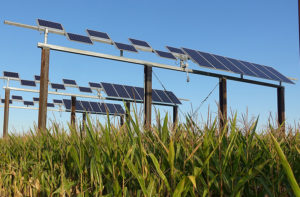A team of engineers, agronomists and economists at Purdue University’s Center for Sustainable Food, Energy and Water Systems (SFEWS), supported by the National Science Foundation, are developing novel photovoltaic (PV) module designs for use on agricultural land to cogenerate electricity while growing food crops. The enabling insights from their modeling results were just published in the October issue of Nature Sustainability and were featured on its cover.
“Computer modeling at Purdue has revealed that — for the most densely populated regions of the U.S., using PV modules to collect solar energy as electricity — there will not be enough rooftop and other conventional land areas available to supply the solar energy for most of the daily needs of the local inhabitants,” said Rakesh Agrawal, the Winthrop E. Stone Distinguished Professor in the School of Chemical Engineering and the lead author. “This means more national and global interdependencies for energy and solar energy-related products, just as with fossil fuels.”
 The way out of these land constraints in a solar economy is to put the PV modules on farmland and then to cogenerate electricity alongside crops.
The way out of these land constraints in a solar economy is to put the PV modules on farmland and then to cogenerate electricity alongside crops.
“However, the challenge is that typical PV module installations cast deep shadows on the land underneath, depriving plants of sunshine. Experiments show these can reduce yields 20% or more for major food crops such as corn, wheat, potatoes, soybeans and rice,” said Peter Bermel, an associate professor of electrical and computer engineering at Purdue, who directed the shadow modeling in the paper.
The paper describes strategies for PV installation and operation that minimize shadow duration and intensity on the land underneath, allowing growth of plants with minimal to no negative net impact on crop yield. Some of the new designs use currently available silicon solar cells in new patterns; others employ new materials and innovative concepts to allow unimpeded transmission of the portion of sunlight that plants need for their growth while using the remaining sunlight to generate electricity. The Nature Sustainability paper is authored by current and former graduate students Caleb Miskin, Yiru Li, Allison Perna, Ryan Ellis and Elizabeth Grubbs, and professors Bermel and Agrawal.
In addition, the modelling results presented in the paper are being used to guide the actual experiments. The SFEWS team has installed some of these PV module structures at Purdue’s Agronomy Center for Research and Education (ACRE) farm, and has begun its first set of experiments to study plant growth and crop yield to gain insights into how plants thrive while electricity is cogenerated from the same land. In subsequent harvesting seasons, different PV panel ideas, as well as different crops, will be tried.
“As we wean ourselves off fossil resources and embrace renewable solar energy, we have a transformative opportunity to meet our daily needs for food, electricity, heat, purified water, transportation and chemicals with locally available solar energy by installing photovoltaic modules on agricultural land to cogenerate electricity alongside farming,” Agrawal said.
Agrawal and Bermel are partnering with Mitch Tuinstra, the Wickersham Chair of Excellence in Agricultural Research and professor of plant breeding and genetics in the Department of Agronomy, and other faculty from Purdue and Florida A&M University on the research.
The success of these trials at ACRE could eliminate competition for land between food and energy. It would enable local availability of energy alongside unhindered crop yields to fulfill local needs in all corners of the world. If successful, farmers will be able to grow major crops such as corn, wheat, potatoes, soybeans, and rice without yield losses, while cogenerating electricity. Farming while cogenerating electricity is called “Aglectric” farming, while farming using PV modules for electricity generation is called PV-aglectric farming. Agrawal envisions that PV-aglectric farming will lead to higher farmer earnings. Whereas most crops can be grown only during summer months, farmers will have electricity as a source of revenue throughout the year.
The research could create microgrids at the county level connecting to adjoining counties, then to neighboring states, generating a national and global impact. Regions of the world with acute energy shortages caused by insufficient fossil resources will be able to prosper by harvesting electricity from local sunlight, even using the cogenerated electricity to increase crop yields and pure water supplies.
The opportunities for meeting local needs with local sunshine are limitless.
Purdue University
www.purdue.edu





Tell Us What You Think!